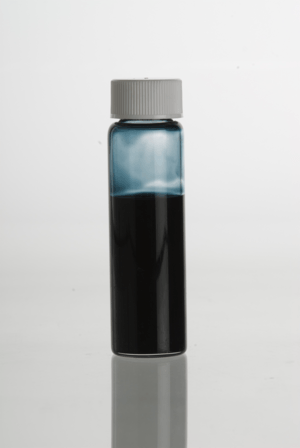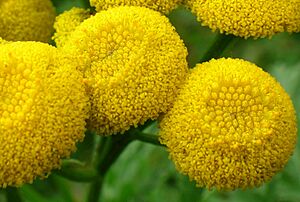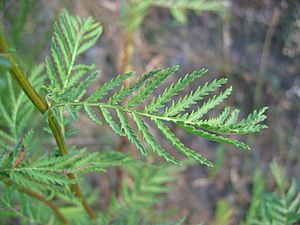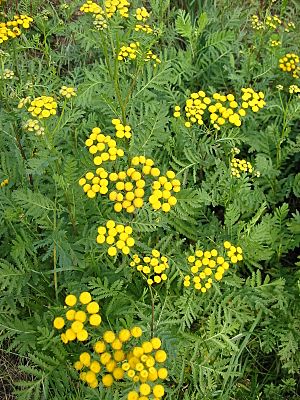Tansy facts for kids
Quick facts for kids Tansy |
|
|---|---|
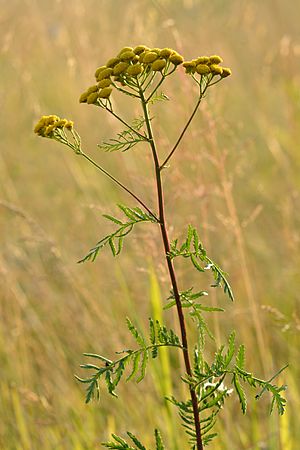 |
|
| Scientific classification | |
| Genus: |
Tanacetum
|
| Species: |
vulgare
|
| Synonyms | |
|
|
Tansy (Tanacetum vulgare) is a perennial flowering plant that grows back year after year. It belongs to the aster family. This plant is originally from cooler parts of Europe and Asia.
Tansy has also been brought to other parts of the world, like North America. In some places, it has grown so much that it has become an invasive plant. People also call it common tansy, bitter buttons, cow bitter, or golden buttons. The word vulgare in its scientific name means "common."
Contents
Discovering Tansy: What It Looks Like
Tansy is a plant with bright yellow, button-shaped flowers. Its leaves are divided into many small parts. This makes them look a bit like fern leaves.
The plant has a strong, straight stem that can be reddish. It usually grows about 50 to 150 centimeters (20 to 60 inches) tall. The leaves are about 10 to 15 centimeters (4 to 6 inches) long.
The round, flat-topped flower heads grow in groups at the top of the plant. They bloom from mid to late summer. Tansy has a smell that reminds some people of camphor or rosemary.
Tansy's Journey: History and Where It Grows
Tansy naturally grows across Europe and Asia. You can find it in most parts of mainland Europe, Britain, and Ireland. However, it does not grow in Siberia or some Mediterranean islands.
Ancient Greeks might have been the first to grow tansy. They used it as a healing herb. By the 1500s, people in Britain thought it was a "necessary" plant for any garden.
Tansy Through Time: How People Used It
Tansy has a long history of being useful. The ancient Greeks were among the first to grow it for its healing properties. In the 8th century, it was grown in the herb gardens of Charlemagne. Monks in Swiss monasteries also grew it.
People used tansy to help with many health issues. It was used for problems like joint pain and tummy troubles. It was also thought to help with fevers and skin sores.
In the 1400s, Christians began eating tansy during Lent. This was to remember the bitter herbs eaten by the Israelites. People believed tansy could help with digestion after eating a lot of fish.
Tansy was also used as a face wash. Some thought it could make skin look brighter and cleaner. In the 1800s, people in Ireland believed bathing in tansy and salt could cure joint pain.
Tansy as an Insect Repellent
Tansy has been used for a long time to keep insects away. It was even used in a special way to help preserve bodies. People would pack tansy into coffins or wrap it in burial cloths. Sometimes, wreaths made of tansy were placed on the dead.
For example, Henry Dunster, the first president of Harvard University, was buried with tansy. When his cemetery was moved in 1846, the tansy still looked and smelled fresh. This helped identify his remains. By the 1800s, tansy was used so much at funerals in New England that people started to dislike it. They linked it too much with death.
During the American colonial period, people rubbed or packed meat with tansy leaves. This helped keep insects away and made the meat last longer. People also wore tansy in their shoes. They hoped it would prevent malaria and other fevers.
Tansy can also be planted next to other crops. This is called companion planting. It helps protect plants like potatoes from pests. One study showed that tansy could reduce Colorado potato beetle numbers by 60 to 100 percent.
In England, people put tansy on window sills to keep flies out. Sprigs of tansy were placed in bed sheets to drive away pests. It has also been used to repel ants.
In the 1940s, a mix of tansy oil and other plants was a known mosquito repellent. Research shows that tansy extracts do repel mosquitoes. However, they are not as strong as some modern repellents. In 2008, scientists in Sweden found that tansy oil could repel ticks by 64–72 percent.
Understanding Tansy's Toxicity
Many types of tansy plants have an oil that can cause skin irritation in some people. If you eat tansy, the oil can be harmful inside your body. It is very toxic to internal parasites. For centuries, herbalists used tansy tea to help get rid of worms.
Tansy is also a strong insecticide. It is very harmful to arthropods, which are creatures like insects and spiders. Because tansy contains a substance called thujone, the U.S. FDA limits its use. It is only allowed in alcoholic drinks, and the final product must not contain thujone.
It is important not to confuse common tansy (Tanacetum vulgare) with Tanacetum annuum. The oil from Tanacetum annuum is very different. It does not have thujone and is dark blue. This is why it is called Blue Tansy Oil. The oil from common tansy is never blue. If a blue oil contains thujone, it means it has been mixed with something else.
The active parts in tansy oil include 1,8-cineole, trans-thujone, and camphor. The amounts of these parts can change depending on the season and the plant. 1,8-Cineole is a toxin that helps protect the plant's leaves from animals that might try to eat them.
Tansy in the Kitchen: Old Recipes
Tansy was once used to flavor puddings and omelettes. Today, this is very rare. However, in Cork, Ireland, it is still used in a sauce for a dish called drisheens.
The herbalist John Gerard (who lived from about 1545 to 1612) said tansy tasted "pleasant." He even suggested eating tansy sweets to help with gout. In Yorkshire, England, people traditionally used tansy and caraway seeds in biscuits served at funerals.
During the Restoration period in England, a "tansy" was a sweet omelette. It was flavored with tansy juice. In a TV show, a chef described the flavor as "fruity" and "sharp," with a cool, mint-like feeling. However, the show's presenter felt sick after trying it.
According to a historian, in the 1800s, Jack Daniel enjoyed drinking his whiskey with sugar and crushed tansy leaf. Tansy can also be used as a substitute for sage in cooking.
Traditional Healing Uses of Tansy
For many years, tansy has been used as a healing herb. This is true even though it can be harmful. In the 1800s, Irish stories suggested that bathing in a mix of tansy and salt could help with joint pain.
A bitter tea made from tansy flowers was used for centuries. It was believed to help treat parasitic worm infections. Tansy cakes were traditionally eaten during Lent. People thought eating fish during Lent caused intestinal worms. Different types of Tanacetum plants are used in traditional medicine. They are used for migraine headaches, nerve pain, and joint pain. They are also used to help with worms.
Tansy Among Native Americans
The Cherokee people use a special drink made from tansy for backaches. They also use the plant as a tonic to feel stronger. Some wear it around their waist and in their shoes. They believe it can help prevent miscarriages. The Cheyenne people use a drink made from crushed tansy leaves and flowers for dizziness and weakness.
Other Ways Tansy Is Used
Some traditional dyers use tansy to make a golden-yellow color. The yellow flowers are also dried and used in flower arrangements.
Tansy is also used as a companion plant in gardens. It is often planted with cucumbers and squash. It is also planted with roses or various berries. People believe it helps keep away ants, cucumber beetles, Japanese beetles, squash bugs, and some flying insects.
Some beekeepers use dried tansy as fuel in a bee smoker. This helps calm the bees.
Images for kids
See also
 In Spanish: Tanaceto para niños
In Spanish: Tanaceto para niños



